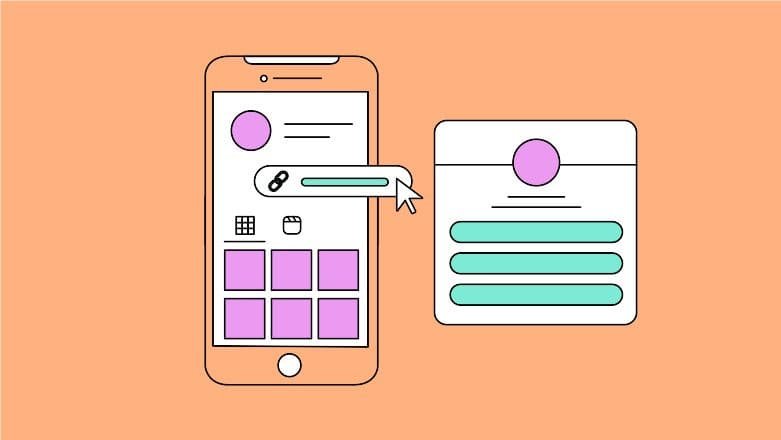Hey, link-breaking badass! No matter where you may be coming from, I’m pretty sure you’ve heard some buzz around that mysterious thing called ‘link in bio’. Ever wondered why? Ever asked yourself what your bio link really is and why it is making such a big deal? That’s exactly what you’re going to discover in this blog post. We’ll be digging deep into the world of biolinks, breaking it down and exploring the unique way that links in bios can change the course of your life and your business. So, grab your favourite beverage, get cozy and let’s get started whilst revealing the strongest secret weapon to links—your way to success.
The Link in Bio Revolution: Your Secret Weapon for Social Media Domination
Here we go! The link in bio is social media marketing—it’s versatile, potent and capable of more than you’d perhaps ever imagine. Essentially, the link in bio is a clickable URL added to your social media profile. But it’s not just a regular link; it’s your portal to driving traffic, engagement and, ultimately, growth for the brand or business you’re representing.
So, for example, because Instagram doesn’t let us buy ads that link out in a regular post, Instagram influencer companies depend on the link in the bio to advertise for their clients. Here’s the thing: the most effective way to build an Instagram business account (so you can monetise it) or launch a blog is to treat your Instagram editorial calendar as your one, go-to space for all of your offerings. And that’s where the link in bio comes into play—everything you promote goes there. A recent study found that, on average, businesses that use a link in bio tool saw an increase in click-through rates of 30 per cent. No small feat.
But it’s not just about plonking any old link in there and then calling it a job well done. Oh no. The link in bio is about acting like an artist. And let me help you paint.
The Anatomy of a Killer Link in Bio: What Makes It Tick?
You might be thinking, ‘It’s a link, for God’s sake! How hard could it be?’ Quite hard, actually. A really good link in bio is a well-oiled machine: everything is synchronised to create an effortless user experience.
Second, you have to choose your destination. Are you sending people to your link in bio, to a website landing page, or curating a bunch of links in one place? Each can be useful, but with different tradeoffs. According to the Sprout Social 2019 Index, 65% of consumers say they visit a brand’s website after seeing it on social media. So, even if you have the perfectly designed, mobile-friendly destination, the link in bio is still important.
And then there’s the link itself—short and sweet is the way to go here. Nobody wants to see one of those mile-long URLs working its way through their bio. That’s why many digital marketers use shorteners or custom domains to cut down on the clutter. Bitly’s stats suggest that branded short URLs receive 34% more clicks on average than generic ones.

Unleash the Power of Your Bio Link: Strategies That Will Blow Your Mind
Fine. Now we have the basics; it’s strategy time. Because, let’s face it, a link in your bio is only as good as the strategy you have in place to use it, and, trust me, there are some insane ways of making the most of that little bit of digital dirt you can get your hands on.
Next, let’s take a look at your ‘link in bio’ landing page—that slice of your own online turf served right there from under your profile picture on social media. Once-complicated coding is now so easy to use that apps such as Linktree, Campsite and Tap Bio give you a palm-sized mini-website to display whatever links you want, embed videos, sign-up sheets and much more, and collect email addresses. This is your online Swiss Army knife.
A recent survey by Influencer Marketing Hub showed that brands can increase their engagement by 40% through the use of links in bio landing pages. In my book, that’s a pretty decent boost.
The Secret Sauce: How to Optimize Your Link in Bio for Maximum Impact
Time for a pivot to optimisation. Sure, you can add a link in your bio. But can your link in my bio actually work for you? That depends on your call-to-action (CTA): What do you want people to do once they’ve clicked on your link? Buy something? Sign up for your newsletter? Read your latest blog post?
Whatever that is, make it very clear. Use active language and create urgency. The CTA tests by Unbounce show that ending a call to action with an action word can increase click-through rates by up to 90%. That’s a lot.
Second, think about the aesthetics. If you’re using a link in the bio tool, you will often have some customisations you can utilise. Use the same brand-related colours and imagery as the rest of your marketing channels—a key part to giving people a sense of continuity between posts and landing pages should mirror your other channels. And also, just adding in the info that it’s for mobile will save time. Statista reports the figure is now at over 90% of active Instagram users accessing the app via mobile.

Beyond Instagram: Mastering the Link in Bio Across Platforms
But, when it happened, it happened on Instagram. Still, I wouldn’t blame you for losing sight of the fact that just because I’m talking about Instagram here doesn’t mean that the link in my bio isn’t going on everywhere else. Case in point: like all good trends with an incubation period on the ‘gram, the link in bio is now a thing on literally everything. Some variation of the link in bio on every possible platform.
First, consider Twitter (or X, as it’s now called). When you tweet, you can include a link, but many still prefer to use a link in their bio to demonstrate their most important content or latest project—a permanent owned tweet, so to speak. Sprout Social found that tweets with links will be retweeted 86% more often than those without. Imagine how well an optimised bio link might perform!
And of course TikTok, where often the link in bio is used to drive visitors away from the platform, perhaps to another social app (my personal experience is woefully small, but I presume TikTokers send users to Instagram to follow their business content), or else to apply an affiliate link for marketing purposes (Statista estimates TikTok’s global active user count at more than 1 billion as of November 2022).
The Future of Bio Links: Emerging Trends and Technologies
Okay, let’s put on our futurist hats for a second, because the last part of this is going to be looking at the bio-links that are coming down the pipeline. The biggest feature I’m looking across within the bio-link world itself is the insertion of e-commerce functionality into links in bio pages, so that you can add purchase options to an entire shop and viewers don’t have to leave their social app. Some of the larger platforms are already experimenting with this, and it’s only going to become more common.
Watch the rapid adoption of AI and machine learning tools to activate your link in bio in real time, specifically by optimising its content for acquiring users at scale, using data from their behaviour and engagement patterns. This is one trend you definitely want to keep up with.
There’s also a focus on personalisation; we could be looking at these bio links appearing in different ways for different people depending on what they’ve interacted with or you know of their interests. One study by Epsilon showed that 80% of your consumers are more likely to purchase after a personal experience. So, this would be huge for conversion.
The Numbers Don’t Lie: The Impact of an Effective Link in Bio Strategy
Fine, fine – I thought we were talking about the beautiful potential of the link in bio strategy here, but let’s get down to brass tacks: what kind of results can you expect from perfecting your bio link? The numbers are pretty good.
Later reported that company pages with a tool for adding a link in bio see an average of 30 per cent improvement in click-through. Now that’s impressive! But wait, there’s more. Brands who are regularly changing out content in their bio link have higher engagement rates—40% higher, in fact—than businesses who go ‘install and forget’.
And conversion rates? They see absolute increases of as much as 25% for brands using optimised bio links, compared with other social media marketing channels. That’s 25% more sales!
Case Studies: Link in Bio Success Stories That Will Inspire You
Let’s make this all a bit more tangible by expanding on some real-world parallels. First up, the fashion retailer ASOS: its implementation of a link in bio strategy updating its latest collections and offers every seven days saw it increase click-through rates by 50% and mobile conversions by a further 20%.
But it doesn’t have to stop at the big stores. For example, a cookbook author started using her bio link as a hub for her recipes, cookbook sales and cooking classes and doubled the number of followers on Instagram and increased email sign-ups by 75%. Sales of her cookbook also rose by 40%.
Conclusion
That wraps it up for now, my friend. I hope you enjoyed this blog post about links in bio: their power, potential, and how your link in bio is so much more than just a URL. In many ways, it’s your whole digital world right there in that one place—a hub for all your content and a powerful lever for driving engagement and conversions. By following the advice we’ve presented and keeping yourself updated on the latest developments, your little link in bio has the potential to become the powerhouse you might be dreaming about for your brand or business.
FAQs
How often should I update my link in bio? That’s not always the answer. It depends on your content, but a good rule of thumb is to update your bio link at least once a week for fresh content and reasons to check back in.
Can I use multiple links in my Instagram bio? Instagram lets you have only one clickable link in your bio. But you can use a link-in-bio tool to make a landing page with many links, which becomes your one bio link, so you’re able to connect several destinations through a single bio.
How do I measure the success of my link in bio strategy? Clicks, views and clicks relative to views expressed as a click-through rate (CTR), total conversions, and the revenue that those conversions generate are the most important to track. Many link-in bio tools provide analytics for you; you don’t need to do anything else, but it would be better to track everything using a service such as Google Analytics if you can.

